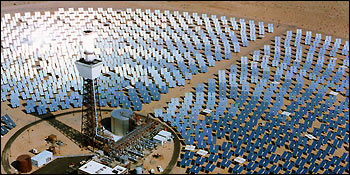
DoD Energy Security Challenges: A Summary of the Hoover Institution’s “Powering the Armed Forces” Report
The Stanford University based Hoover Institution recently released a report recommending Department of Defense’s initiatives to overcome our nation’s energy security challenges. The report was written after the Hoover Institution’s task force on Energy Policy held a conference with senior Department of Defense (DoD) officials. Energy experts, scientists, economists and military fellows all gave their input on the role of the DoD in overcoming the nations energy security challenges. The report is a summary of their findings, recommending investment in distributed-power sources and biofuels among broad strategic planning.
The DoD is the largest organizational consumer of energy in the world. The military’s large consumption of energy is currently an inhibitor to our national defense at the strategic, operational and tactical levels. The report recommends the DoD prioritize energy security as a means to a more effective military force – “one that is more agile, lethal, adaptable and better able to defend the nation.”
In order for the military to become more effective, its energy usage must meet the demands of global military operations. The report states that the DoD’s greatest energy related challenge “is to ensure that U.S. forces can meet a threat, anywhere in the world.” To do so, our military must improve the efficiency of its energy use, diversify its energy sources, and build a military force that uses energy as a strategic advantage.
The report recommends that the military should also be pioneering energy security technology, not just for military use, but also as part of a broader initiative to strengthen the nation’s vulnerable energy infrastructure. The report states that “we are just at the beginning of game-changing new technologies in several fields.” As the DoD promotes technologies to make our military more effective, they will also be pioneering technology that will reduce risks to the nation’s energy infrastructure.
The DoD is uniquely capable of using its demand pull to bring commercial-scale, economically beneficial innovations and developments “that normally require decades and billions of dollars to complete.” The military technology developed to protect our troops on the battlefield will “migrate” to become civilian technology, used to protect our energy use at home.
Highlighted in the report are the security risks posed by our dependence on centralized electrical grids along with recommendations for the military’s future research and development.
Centralized electrical grids are threatened by physical disruption from the weather or attacks, cyber disruption (like we have seen in Iran’s nuclear facility), electromagnetic pulse attacks and regulatory disruption. The report suggests that the military lessen its dependence on vulnerable centralized electrical grids by researching and procuring distributed-power sources (DPS).
In tandem with a recent Brookings Institution report, the Hoover report recommends that efforts be made to partner with private institutions to research the impacts of DPS’s, as substitutes for a centralized electrical grid. This would involve analyzing the risks and benefits of DPS’s for DoD operations. DPS’s would generate electricity from many smaller and more secure energy sources in contrast to large centralized power plants, with expansive vulnerable infrastructure.
Through large scale procurement of DPS’s the military could help drive down the costs of renewable DPS technology and pioneer technology for other sectors of the economy. The report recommends expanding current DPS programs such as the Rucksack Enhanced Portable Power System, used in Afghanistan to reduce the use of liquid fuels on the front line.
The report also recommends the continued support of critical energy R&D. Further investment needs to be made in energy storage, lightweight materials, and alternative fuels. The report cites that “perhaps the most critical of these areas is biofuel.” The report recommends a department wide biofuel’s strategy that supports viable biofuels feedstock. Biofuels should serve as “critical energy security benefit” but only if feedstock can be produced “at a meaningful scale and at an affordable cost.”
The report concluded that the military must overcome a culture of energy inefficiency if it seeks to overcome energy security challenges. Military officials claimed that too little is thought of energy efficiency in the armed forces. This sense can be overcome by incorporating energy security into strategic and operational planning and DoD acquisition. A large part of such planning would be identifying and implementing energy-performance metrics to mange energy efficiency.
The report is an informative contribution to the literature surrounding the DoD’s energy future offering an insightful perspective on energy security challenges and opportunities. The report illustrates that the DoD’s need to provide leadership in energy security policy.






